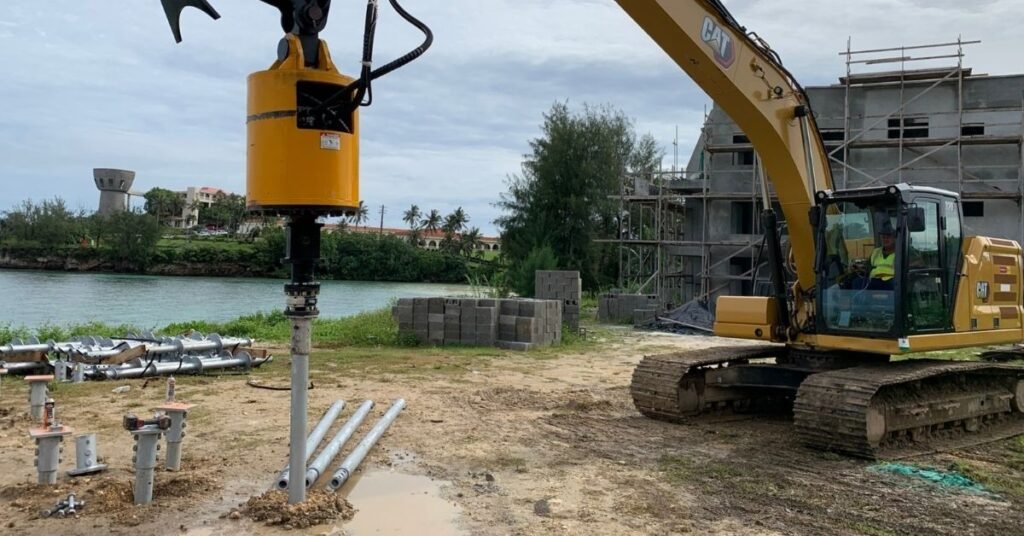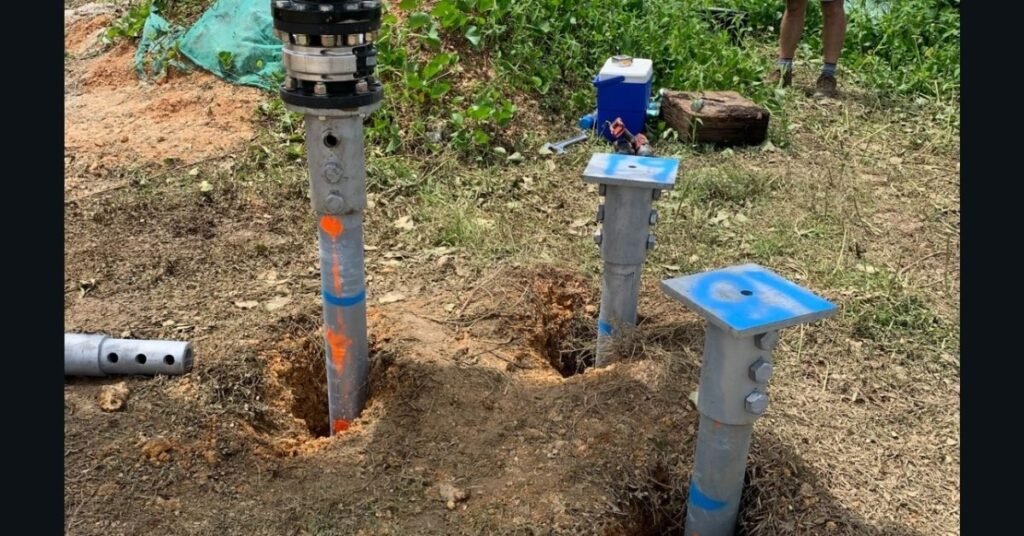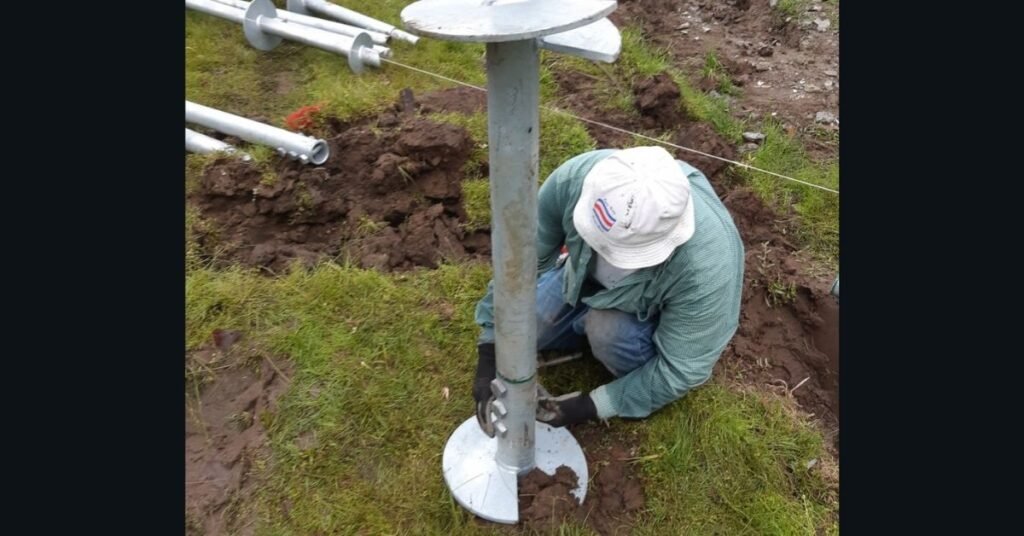ARTICLE
When to Use Helical Piles

The decision to use helical piles over traditional concrete depends heavily on your project’s specific needs, including soil conditions, site access, budget, and timeline.
This guide clarifies the terminology, outlines the best applications, and provides a clear comparison to help Australian homeowners and builders make an informed choice.
Table of Contents
When to Use Helical Piles
The versatility of screw piles makes them a suitable choice for a wide array of projects across Australia, from small residential additions to significant commercial structures.
Their unique installation method and performance characteristics make them particularly effective in solving common construction challenges.
Ideal Applications for Residential Construction
For Australian homeowners, screw piles offer a modern solution for many common building projects.
When constructing a new home, they provide an incredibly stable foundation, especially on sloping blocks or sites with poor soil quality where traditional methods would require extensive and costly earthworks.
For home extensions and renovations, their key advantage is the minimal disruption. You can add a new room or level to your home without turning your backyard into a major excavation site.
Smaller projects also benefit greatly. Building a deck, pergola, or carport on screw piles is significantly faster and cleaner than digging holes and mixing concrete.
The piles are installed quickly and are immediately ready for the frame to be attached. Moreover, screw piles are a leading solution for foundation repair and underpinning.
When an existing home shows signs of sinking or cracking due to ground movement, screw piles can be installed to stabilise the foundation and, in some cases, re-level the structure with minimal intrusion.
Suitability for Commercial and Civil Projects
The benefits of speed and minimal impact extend to larger-scale projects. Screw piles are frequently used as foundations for modular and portable buildings, mining camps, and communication towers, where rapid deployment is essential.
They are also an excellent choice for environmentally sensitive projects like boardwalks through wetlands or viewing platforms in national parks, as their installation leaves a very small footprint. The fact that they can be unscrewed and removed also makes them a sustainable and reusable foundation option for temporary structures.
Choosing Between Screw Piles and Other Foundations
Once you understand that helical and screw piles are largely synonymous, the more important question arises: when should you use them instead of other foundation types, particularly traditional concrete?
The choice hinges on factors like installation speed, cost-effectiveness, and suitability for specific ground conditions.
Screw Piles vs. Traditional Concrete Piers in Australia
The classic Australian home has often been built on concrete stumps or piers. However, screw piles offer compelling advantages that challenge this tradition. The primary benefit is speed.
A full set of screw piles for house foundations can often be installed in a single day. There is no need for large-scale excavation, no waiting for concrete trucks, and no curing time.
The foundation is ready to be built upon immediately after installation is complete. This dramatically accelerates the project timeline.
Furthermore, the installation process creates minimal site disturbance.
The equipment is often smaller and more agile than that required for concrete work, making it perfect for sites with limited access or where established gardens and neighbouring properties need to be preserved.
There are no large piles of excavated soil (spoil) to be removed from the site, which is another saving in both time and cost.
When Should You Not Use Screw Piles?
Despite their versatility, screw piles are not a universal solution. Their primary limitation is in ground that is impenetrable to the screw mechanism.
This includes sites with shallow bedrock, ground filled with large, dense boulders, or certain types of man-made obstructions.
Attempting to install a screw pile in these conditions can damage the pile or prevent it from reaching the required depth and torque, compromising its structural integrity.
This is why a geotechnical investigation or soil testing before works commence is not just recommended, but essential.
An engineer needs to know what is below the surface to design an effective and safe foundation.

The Impact of Australian Soil Conditions
Australia’s diverse and often challenging geology is a primary reason for the growing popularity of screw piles.
A foundation’s success is entirely dependent on its ability to handle the specific soil it sits in. Screw piles can be engineered to perform reliably in some of the most problematic soil types found across the country.
Reactive Clay Soils (Adelaide, Melbourne, Western Sydney)
Vast areas of Australia are dominated by reactive clay soils.
These soils are notorious for shrinking and swelling dramatically with changes in moisture content, swelling during wet periods and cracking during dry spells.
This constant movement exerts immense pressure on building foundations, leading to cracked walls, sticking doors, and significant structural damage.
Screw piles solve this problem by being installed to a depth that extends beyond the reactive clay zone.
They anchor the structure in the stable, deeper ground, effectively bypassing the problematic upper layers and creating a stable foundation solution.
Sandy and Coastal Soils (Perth, Gold Coast, Coastal NSW)
In coastal regions, the soil is often loose and sandy, which can present challenges for traditional shallow foundations.
Screw piles excel in these conditions. As the pile is screwed into the ground, the helical plates compact the loose sand around them, increasing the soil’s density and creating exceptional load-bearing capacity.
For coastal applications, corrosion protection is paramount. Reputable installers use heavily galvanised steel piles to resist the corrosive effects of the saline environment, ensuring the foundation’s longevity.
Alluvial and Fill Sites
Many urban and developing areas are built on alluvial soil (deposited by rivers) or on sites with uncontrolled fill. These soils are often weak, unconsolidated, and have poor bearing capacity.
A standard slab or shallow footing would be at high risk of sinking or shifting. Screw piles provide a perfect engineering solution by acting as stilts, transferring the building’s weight through the weak upper layers of soil down to a competent, load-bearing stratum or bedrock deeper below.
The Role of a Geotechnical Investigation
Regardless of the project, a geotechnical investigation is the critical first step. A geotechnical engineer will analyse soil samples to determine its type, strength, and characteristics.
This soil testing report provides the essential data needed to design the screw pile system correctly.
The report will dictate the required pile diameter, shaft thickness, helix configuration, and installation depth needed to safely support the structure for its entire design life, ensuring compliance with the Building Code of Australia.

Durability, Longevity, and Australian Standards
A key concern for any homeowner or builder is the long-term performance and durability of their foundation.
When designed and installed correctly, screw piles offer a robust and long-lasting solution that fully complies with strict Australian building regulations.
How Long Do Helical Piles Last?
The design life of a professionally installed screw pile is typically in excess of 50 years and can often match the 100-year design life of a new building.
The primary factor influencing longevity is the rate of corrosion of the steel. In most common soil types, this process is very slow.
The pile’s design, particularly the thickness of the steel and the quality of its protective coating, is engineered to ensure it maintains its structural integrity for many decades.
Corrosion Protection and Material Quality
To combat corrosion, all reputable screw piles used in Australia are protected by hot-dip galvanising.
This process involves coating the steel pile in a layer of zinc, which acts as a sacrificial barrier against corrosive elements in the soil.
This galvanising must meet Australian Standards (AS/NZS 4680) to ensure a sufficient thickness and quality of protection. In particularly aggressive or acidic soil conditions, additional measures like epoxy coatings or sacrificial anodes may be incorporated into the design to provide even greater corrosion protection.
Compliance with the National Construction Code (NCC)
It is important for builders and homeowners to know that screw piles are not a fringe product; they are an engineered foundation solution fully recognised and accepted under the National Construction Code (NCC) of Australia.
To be compliant, the system must be designed by a qualified structural engineer based on a site-specific geotechnical report.
The installation must then be carried out by experienced professionals in accordance with the engineer’s design and specifications, ensuring a safe, reliable, and legally compliant foundation for your home or building.
When is the Best Time to Use Helical Piles in Australia
In the Australian construction landscape, the terms helical pile and screw pile essentially describe the same innovative foundation technology.
The decision to use this system is less about the name and more about its suitability for your specific project.
Screw piles offer an unmatched solution for sites with problematic soils, such as reactive clay or loose sand, by anchoring the structure in stable ground.
Their rapid, low-impact installation makes them ideal for projects where time is critical or site access is limited.
While they may not be the answer for rocky ground, their overall efficiency and engineered reliability present a compelling alternative to traditional concrete foundations.
Ultimately, consulting with a geotechnical engineer and a reputable installer is the best way to determine if screw piles are the right choice for your build.
Frequently Asked Questions About Helical and Screw Piles
What Is the Difference Between a Helical Pile and a Screw Pile?
In Australia, there is virtually no practical difference for a homeowner or builder. The terms are used interchangeably to describe a steel pile with helical plates that is screwed into the ground. While minor technical distinctions may exist between manufacturers, they both refer to the same foundation principle.
When Should You Not Use Screw Piles?
You should not use screw piles on sites where the ground contains shallow bedrock, large boulders, or other solid obstructions that would prevent the pile from being screwed to its required depth. A geotechnical report is essential to identify these conditions before planning a foundation.
What Are the Disadvantages of Helical Piles?
The main disadvantages of helical piles include their unsuitability for very rocky ground, the need for specialised installation equipment and certified installers, and an upfront cost that can sometimes be higher than simple concrete footings. Their performance is highly dependent on a quality product and correct installation.
Are Helical Piles Cheaper Than Concrete?
It depends on the project. While the upfront material and installation cost of screw piles can be higher than simple concrete footings, they can be more cost-effective overall. Savings come from a much faster installation time, no costs for soil removal, and reduced labour, allowing the building project to proceed much sooner.
How Long Do Helical Piles Last?
A properly designed and installed screw pile made from high-quality, galvanised steel can have a design life of over 50 years, and often much longer, easily matching the lifespan of the building it supports. The primary factor affecting longevity is the rate of corrosion, which is managed through quality materials and coatings that meet Australian Standards.
What Are the Advantages of a Helical Screw Pile?
The main advantages are speed of installation, minimal site disturbance, no excavated spoil to remove, immediate load-bearing capacity, suitability for a wide range of difficult soil conditions (like clay and sand), and the ability to measure their capacity during installation for quality assurance.
Need a quote or more info? Start here.
Contact Us
info@helicalpilesaustralia.com.au
+61 2 7251 9258
Mon–Fri, 8:00am–5:00pm AEST

Built for complexity.
Engineered for certainty.
A trusted partner for large-scale energy and infrastructure projects where precision isn’t optional, it’s mandatory
© 2025 Helical Piles Australia. All rights reserved.
Privacy Policy
Contact Us
info@helicalpilesaustralia.com.au
+61 2 7251 9258
Mon – Fri, 8:00am – 5:00pm AEST
Location
Ground Floor 3, 189 Kent St
Sydney, NSW 2000

